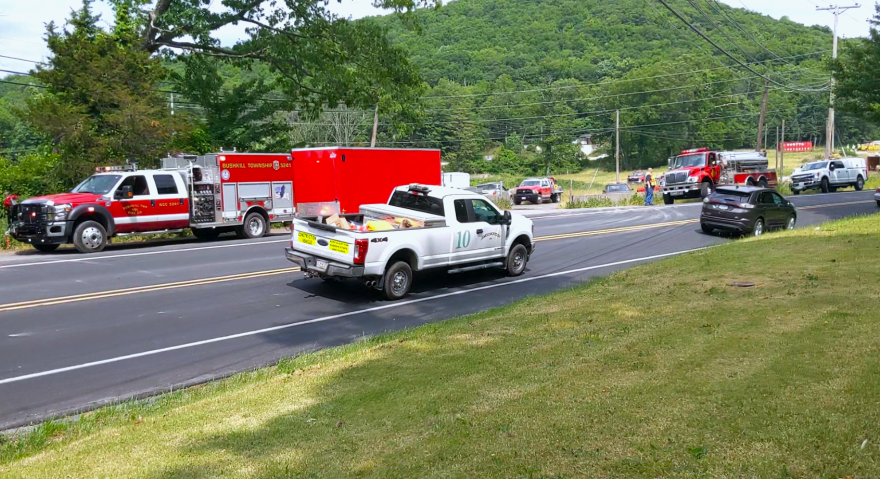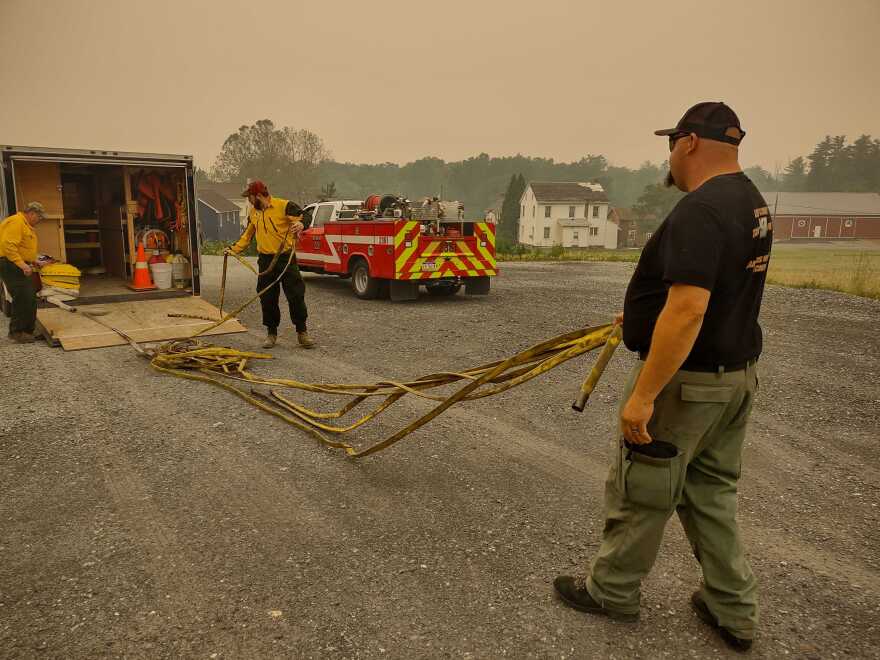HEIDELBERG TWP., Pa. — Randy Schmoyer strode across the parking lot of the Germansville Fire Station last week and looked up at the hazy, red sky. Social media was abuzz with anxiety and concern about the historic levels of air pollution across the Mid Atlantic. Massive Canadian forest fires 600 miles away made the Lehigh Valley sky look and smell like a smoking lounge.
But for Schmoyer, a member of the Lehigh County Forest Fire Task Force 99, the ashy scent in the air made him nostalgic. He and other local firefighters have traveled to the Pacific Northwest for years to battle raging forest fires.
"You'd roll out of your tent in the morning and it would look like this," Schmoyer said with a twinkle in his eyes.
- Pennsylvania's first line of defense against wildfires are fire wardens, a collection of about 1,300 fire fighters based largely out of local fire companies
- Fire wardens, including members of the Lehigh County Forest Fire Task Force 99, undergo specialized training to deal with challenging conditions unique to battling outdoor fires
- Pennsylvania has already seen more wildfires in the first six months of 2023 than all of 2022, according to state data
Experience like Schmoyer's may be more important for firefighters across the Keystone State this year. While Pennsylvania rarely, if ever, sees the massive forest fires that threaten much of the American West, the state has seen an enormous spike in wildfires since 2020. And 2023 is already outpacing even those elevated levels.
Most fire fighting units in the Lehigh Valley are jacks-of-all-trades that need to respond to whatever situation arises — car accidents, structure fires and gas leaks, to name a few. But the task force, also known as the Flametamers, is the only fire fighter unit in the Lehigh Valley that specializes in brush fires. The unit, which dates back to 1991, is primarily based out of the Germansville Fire Company but draws support from eight other stations across the county.
Chief Randy Metzger said his roster of about 40 firefighters — all of whom volunteer for other Lehigh County fire stations — undergo arduous training and must pass a fitness test by carrying 45 pounds of gear three miles in 45 minutes. To aid them, they're issued lighter protective gear to make it easier to haul hand tools and water through rough terrain.
"We're required to carry whatever we need with us when we're out there," he said. "We're going to hike a mile or so around here" to get to some locations.
While some members sign up to head to Montana, Idaho, California and other western states to assist with large forest fires, there are local opportunities for hands-on experience, he said. The Flametamers assist the state with controlled burns on Game Commission lands and the Trexler Nature Preserve.
That experience has come in handy of late. On June 2, the crew hauled nearly a half-mile of hoses up the rocky slopes of Bake Oven Knob on the Appalachian Trail, Metzger said. The extremely dry conditions allowed a small brush fire to burn four inches down into the soil and duff, requiring crews to keep dousing the vegetation, he said.
On June 7, the team assisted with the 10-acre brush fire along Route 33 in Plainfield Township. Responding crews managed to contain the blaze relatively quickly by burning a fire line, but tricky weather patterns made it challenging.

"The guys that were up there saw 180-degree wind shifts, and it goes from six-inch flames to four-foot flames, and now they're coming at you instead of going away from you," Metzger said.
Busy firefighters aren't just a Lehigh Valley phenomenon. The number of reported wildfires across Pennsylvania has spiked since 2020, according to data compiled by the state's Department of Conservation and Natural Resources. Michael Kern, chief of the Division of Forest Fire Protection, said part of that increase comes from a greater emphasis the department has placed on record keeping. But it's also due to dryer weather and the growing popularity of outdoor recreation since the pandemic, he said.
But this year is already outpacing that spike, data shows. Wildfires in 2023 have burned nearly as much acreage as fires in the previous three years combined.
PA WILDFIRE REPORTS
2017 — 533 reported fires — 1,650 acres burned
2018 — 690 reported fires — 1,843 acres burned
2019 — 536 reported fires — 693 acres burned
2020 — 1,507 reported fires — 3,033 acres burned
2021 — 1,371 reported fires — 2,968 acres burned
2022 — 1,036 reported fires — 2,700 acres burned
2023 to date — 1,412 reported fires — 8,561 acres burned
Data courtesy of the Pennsylvania Department of Conservation and Natural Resources
"It definitely is concerning, but I don’t think it’s time to panic," Kern said of the elevated number of wildfires.
For over 100 years, Pennsylvania's first line of defense against wildfires have been forest fire wardens. These 1,300 or so firefighters, the vast majority of whom are volunteers at local departments, are appointed by the Bureau of Forestry to prepare for and respond to wildfires, Kern said. The state helps connect these firefighters with funding for specialized training and equipment.
Lehigh and Northampton counties have 46 fire wardens, including Metzger and Schmoyer. Those wardens are in turn encouraged to build their own rosters of firefighters to respond to wildfires, Kern said. In most cases, those rosters are built from the ranks of local fire stations, he said.
Both Kern and Metzger agreed the Lehigh Valley is well-equipped to battle wildfires. The biggest challenge most Pennsylvania fire companies face is a lack of manpower, Kern said. And while recruitment has proven tricky for some local stations, the Valley (and Southeast Pennsylvania as a whole) has a growing population to draw from, Kern said. In parts of western and central Pennsylvania, shrinking populations have made it difficult to shore up aging fire crews with new blood.
But the area's population creates its own challenges. Wildfires in Pennsylvania are almost always man-made, Kern said. Case in point is the brush fire in Plainfield Township; Metzger said it appeared to have multiple ignition points along Route 33, indicating hot exhaust from the same vehicle could be the culprit. More people means more opportunities for a fire to start.
In addition, a lower population usually limits the potential for damages, Metzger said. The Flametamers are primarily responsible to putting out fires along the Blue Mountain and the northern reaches of Lehigh County. The rural terrain can present challenges, but Metzger said first responders along South Mountain or Interstate 78 don't have it any easier. The county task force has made a point to visit communities to its south with higher risks for wildfires, including Salisbury Township, he said.
"We obviously have the [Blue] mountain that we have to worry about, but not as many houses buried in that [South] mountainside. And that, that's the real challenge," he said.


